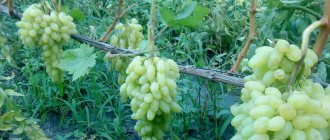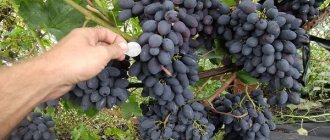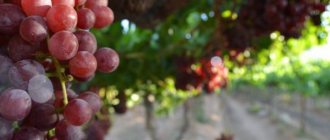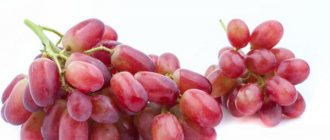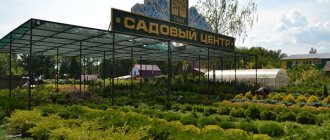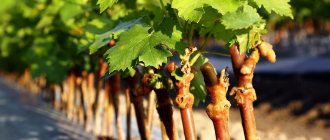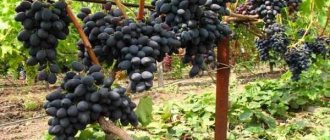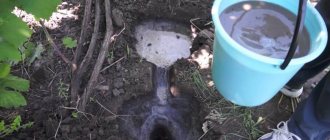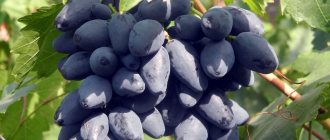Description of planting and care
When planting Hungarian sultanas, care should be taken to choose the right planting site with sufficient nutritional area.
Selecting a location
The grapes should be planted on the western or eastern side of the building in a well-lit and spacious area. The distance between the bush and the support should be at least one meter, and seedlings should be planted at a distance of three meters from each other.
Grapes are planted as seedlings or grafted onto another plant. You can start planting from the beginning of April or in October - November a week before the start of frost.
Soil preparation and planting
- You should dig a hole one meter deep and more than half a meter wide.
- It is necessary to pour a drainage layer of expanded clay or crushed stone onto the bottom, then fill it halfway with fertile and fertilized substrate (to do this, mix turf soil, sand, humus and wood ash).
- A peg should be buried in the recess, as well as a plastic pipe for irrigation.
- The seedlings must be placed in a hole, covered with earth, watered abundantly and mulched.
- After planting, grape seedlings should be cut into two eyes, the scion site should be left on the surface.
Description of diseases and pests
If Kishmish 342 grapes are processed in a timely manner for the purpose of prevention, then many diseases and pests will not be able to damage the plant. But there is still a minimal risk of infection.
- In the spring, the plant must be treated with a solution of Bordeaux mixture and certain biological products.
- When pruning grapes, infection of the cuts should be avoided.
- Bushes should be thinned regularly.
However, in addition to various diseases, raisins 342 grapes can be damaged by parasites.
- Bunches of ripe berries can be protected from wasps using mesh or gauze bags, placing the bunches in them. Also, in the area where grapes grow, you can place sweet sticky baits with a pronounced aroma. Also effective is treating with smoke or spraying plants with a vinegar solution.
- Spider mites also attack grape bushes. There are about forty varieties of this pest. The mite lays eggs in the bark of the plant near the roots and entangles the bush with a sticky web. Subsequently, the plant dies. The mite is located and becomes clearly visible on the inside of the leaves. At the initial stage, damage by the parasite appears in the form of dark spots on the leaves. If a spider mite is detected, the bush must be immediately treated with insecticides; folk remedies can also help in the fight against parasites.
- The leaf roller is a beautiful and safe butterfly for Hungarian grapes, but its caterpillars are capable of destroying seventy-five to ninety percent of the vineyard, eating the green part of the vine and bunches of berries. As a preventive measure, butterflies should be regularly treated with chemical and biological substances in the summer.
- The May beetle itself does not pose a threat to grapes, but its larvae, which live in the soil, can cause enormous damage to the root system of bushes, feeding on its tissues. To prevent the reproduction and spread of larvae, the soil should be thoroughly dug up and checked for the presence of pests before planting. If the grapes begin to wither and become sick, it means they are damaged by the larvae of the cockchafer. To save the plant, it is necessary to carry out deep treatment of the soil with insecticides.
Plant care
Immediately after planting, young seedlings should be provided with special care:
- regular watering;
- loosen and fertilize the soil;
- treat the soil with pest repellents;
- three months after planting, the apical shoots of the grapes at the end of the branches should be cut off.
Rules for caring for an adult plant:
- annually cut off up to ten formations on the grapes that unite the buds and ensure their full development;
- In the summer, stepsons and rods are cut off to prevent unnecessary growth of the plant.
- To increase the size of the berries, the plant should be treated with a gibberellin solution.
Hungarian sultana 342 has a strong immunity to fungal diseases, however, it is quite often attacked by various parasites.
Reproduction methods
There are several ways to grow Kishmish 342 grapes on your plot. Some of them are more popular, some less.
Cuttings
The woody vine is cut into pieces in the fall, placed in a bucket with substrate, and taken out to a cool place. In the spring, the cuttings are planted in pots, cared for, and after the young bushes develop, they are planted on the site.
Seedlings
Grape bushes, purchased on the market or grown independently, are planted on the site in spring or autumn. For the winter, young bushes must be covered with spruce branches and agrofibre.
By grafting method
Grape grafting is usually done in the spring. To do this, the trunk of the bush chosen as a rootstock is cut horizontally, and a slit 3-4 centimeters deep is made with a grafting knife. A Kishmish stalk, peeled with a wedge, is inserted into the split and tied with a ribbon.
By layering
In the spring, grape cuttings are placed in shallow grooves, secured, and covered with earth. The place where the vine comes into contact with the ground is looked after all summer: watered, loosened the soil, and grass removed. When new bushes appear, they are separated from the mother plant and planted on the site.
What does it look like
If we take the description of the Kishmish variety and compare it with its hybrid form, then we can confidently say that the second has a slightly changed taste. And about everything else in order.
Hungarian berries are medium in size and reach 17 mm
- Hungarian berries are medium in size and reach 17 mm, but their weight will be approximately 4 grams. Unlike the classic Kishmish, the berries are oval. They are green in color. Naturally, there are no seeds in berries. According to winegrowers, sometimes there are small seeds. But this happens rarely and can be considered an exception to the rule. Juiciness, increased sugar content.
- The bunch is cone-shaped and weighs up to half a kilogram. It cannot be said that the fruits are densely located on it. Loose without a strong fit, which is classified as medium density. It has been noted that the older the shrub vine is, the more each bunch will weigh.
- Among other characteristics, increased productivity should be noted. Every gardener will be happy to receive such a quantity of fruits from one bush in one season. At the same time, Kishmish Hungarian is resistant to diseases that other varieties are so afraid of.
- Frost-resistant. Able to survive up to 26 degrees below zero without additional shelter. True, experienced winegrowers still recommend making a shelter for the bush. After all, anything can happen in life. And frost can strike at night, when the owner does not even notice.
Such hybrid forms are highly valued and protected. Not every grape has such a list of characteristics. In addition to all that has been said, Hungarian Kishmish can be planted in the soil in the northern regions. As a rule, in such lands it is possible to grow a technical variety, of which there are several types. There is also the opportunity to engage in full-fledged cultivation of delicious grapes. Interesting fact. One shoot always produces two full clusters. In this case, density, shape and weight will be normal.
Properties
Despite the small size of the berries, Kishmish grapes are in great demand among buyers. This is due not only to the pleasant taste and aroma of the fruit, but also to the absence of seeds in the pulp.
Calorie content
The energy value of Hungarian grape berries is 69 Kcal per 100 grams of product. It is rich in carbohydrates (17.2 grams), and also contains proteins (0.72 grams), fats (0.16 grams), vitamins, and many useful micro- and macroelements.
Benefits and harms
Kishmish 342 grapes bring the following benefits to the human body:
- strengthens the walls of blood vessels;
- removes bad cholesterol;
- normalizes the functioning of the gastrointestinal tract;
- has an antioxidant effect;
- improves complexion;
- removes heavy metals;
- has a diuretic effect.
In addition to the benefits, grapes can cause harm. It should not be used by people with diabetes, liver disease, or caries.
Acidity
Grape berries contain a large amount of sugar - 20-21%, acidity is 6.5-7.5 grams per 1 liter. Such indicators are both an advantage and a disadvantage of the variety: ripe berries begin to be precipitated by wasps, which are a real scourge of grapes.
Characteristics of the bush
Kishmish 342 is a tall planting with well-branched shoots. This property must be taken into account when choosing a place to plant a crop. The variety is self-fertile; replanting grapes of other varieties for pollination is not necessary.
The grape shoots of an adult plant are thick, woody, and can reach a length of 5 meters. The young vine is smooth and green. The leaves are large, cut into 3 parts. They are located on large petioles attached to the vine.
Read also: Cottage villages in the Bogorodsky district of the Nizhny Novgorod region
Bunch
The grape brush has a cylindrical shape. Its weight varies from 400 to 900 grams. The berries are oval, green-yellow in color, weighing 3-4 grams. On old vines the clusters grow larger than on young shoots.
Productivity
Under favorable conditions, a gardener collects 20-25 kilograms of berries from a bush. Yields are affected by weather conditions, as well as the work carried out by the winegrower during the season. Fruiting of Kishmish 342 is stable. The berries are picked in August.
Note! You can make raisins from Kishmish 342 grapes directly on the bush by twisting the bunch: the berries are first dried in the sun, then dried naturally on the planting.
Taste qualities
The skin of the Kishmish 342 grape is thin, the flesh is dense, sweet, with the aroma of nutmeg. Experts gave the berries a score of 9.5 points out of 10. The absence of seeds in the fruit played a significant role in this.
Winter hardiness and drought resistance
Hungarian grapes can withstand freezing down to -26°C without shelter. Due to this characteristic, it can be grown in central Russia. The variety has good drought resistance; watering is required during periods of severe drought.
Disease resistance
The immunity of the Kishmish 342 grape is at a high level, but under unfavorable conditions it can be affected by mildew, anthracnose, and gray rot. To prevent diseases, it is necessary to spray the bushes with antifungal drugs, starting in early spring.
Grape variety Kishmish GF-342
Farmers from the southern regions do not have any difficulties with choosing grapes: the range of varieties is very wide. But for residents of the middle zone, the Urals, and Belarus, it is very difficult to choose grapes that could develop and bear fruit normally in difficult climatic conditions. One of the universal and very resistant to external factors varieties is Kishmish 342. Some people know this hybrid under the name Hungarian, other gardeners know it by the abbreviation GF-342 - the demand for this variety of Kishmish is very high. The hybrid, indeed, deserves the closest attention, because it has a lot of advantages, is unpretentious and does not require complex care.
A detailed description of the Kishmish 342 grape variety with photos and reviews from gardeners can be found in this article. Here we will talk about the strengths and weaknesses of the Hungarian hybrid, and provide recommendations for its cultivation and care.
Advantages and disadvantages of the variety
Grapes Kishmish 342 has the following positive characteristics:
- rapid growth of culture;
- early fruiting;
- high productivity;
- absence of seeds in berries;
- versatility of use;
- resistance to many diseases;
- storage duration.
Read also: Neva rotary snow blower SMB 1
Negative characteristics include the susceptibility of berries to wasp attacks, as well as their cracking from rainfall.
Features of cultivation
Grapes 342 will not cause trouble for the summer resident, because this hybrid is very unpretentious and is suitable even for beginning winegrowers. The variety pleases with the good quality of cuttings and the possibility of propagation by root and grafting methods. In order to get a bountiful harvest, the farmer does not have to constantly care for his vineyard - Kishmish requires the simplest care: watering, fertilizing, preventative treatment, pruning.
Landing rules
The most important condition for the successful cultivation of Kishmish 342 grapes is the choice of a suitable place for it. This hybrid feels great in an area with good lighting and reliable protection from wind and drafts. The best place to plant the cuttings will be a sunny area near the wall of a house or outbuilding, not far from a high hedge.
The right time for planting Kishmish can be either spring or autumn. In the spring, cuttings are planted when the soil has warmed up thoroughly and the threat of return frosts has passed. Usually planting occurs at the end of April - beginning of May. If grapes are planted in the fall, then this should be done at least a month before the onset of frost (October is perfect for planting).
When preparing planting holes, it is necessary to take into account the strong branching and large height of the Kishmish vine. This variety is planted at intervals of 3-4 meters between neighboring bushes or other plants. The holes should be large and deep: about 70 cm deep and 80 cm in diameter.
The soil taken out of the hole is mixed with a bucket of humus and a liter jar of wood ash. Mix well. After planting, the grafting site should be above the ground. Immediately after planting, it is recommended to cut the cuttings into two buds.
Necessary care
In the first year after planting, all care for Kishmish 342 grapes consists of regular watering, loosening the soil and at least once feeding the seedling with mineral fertilizers.
In subsequent seasons, the work of the winegrower will be as follows:
- Annual pruning of the vine, which is performed in early spring. It is recommended to cut Kishmish 342 into 6-7 buds, normalizing the shoots so that no more than three clusters ripen on each.
- Loosening the soil after each watering or rain. To make your work easier, you can mulch the soil around the grapes with sawdust, dry leaves or other organic material.
- Hybrid 342 will have to be watered infrequently; these grapes require additional moisture only during periods of prolonged drought. Since the variety is early, its growing season takes place in June and the first half of July, when there is usually no drought in temperate climates.
- In mid-summer, Kishmish needs to be fed with a phosphorus-potassium complex - this will improve the quality of the fruit and help increase the size of the berries. In late autumn, the grapes are fed with organic matter (humus, compost, wood ash, bird droppings).
- Although variety 342 is resistant to fungal infections, it is necessary to prevent these diseases. This treatment is especially important in rainy and cool summer conditions. Fungicidal preparations are combined with insecticides, protecting the vine from spider mites, leaf rollers, and chafer larvae. In spring, you can use Bordeaux mixture or biological protection products for grapes.
- Ripening bunches must be protected from wasps. To prevent these insects from damaging most of the crop, bunches of grapes are placed in special bags and wrapped in mesh or gauze. Wasp traps are also effective as a means of control.
- In the northern regions (in the Moscow region, in the Urals, for example), Kishmish grapes must be covered for the winter. The vine of this variety is quite elastic, so it is difficult to bend it. But the shoots will have to be tied and bent to the ground in order to be covered with special material. Spruce or pine spruce branches, dry leaves, sawdust, and agrofibre are suitable as shelter. As soon as snow falls, it needs to be collected throughout the area and a shelter mound built.
The harvested crop can be used for different purposes: eating table berries fresh, preparing wine and juices, drying fruits to obtain raisins. By the way, hybrid 342 can be dried to the state of raisins directly on the vine. To do this, the bunches must be placed in protective bags and turned regularly.
Diseases and pests
To avoid contamination of the crop, it is recommended to treat the plant with Bordeaux mixture or other biological products every spring. Kishmish 342 rarely gets sick. The main danger to the plant are insects: wasps, chafers, spider mites and leaf rollers. Without proper care, grapes can lose up to 90% of shoots and leaves.
Description of grapes Kishmish 342
The early-ripening variety has vigorous bushes and ripens in 110–115 days from the moment the ovaries form. You can wait for ripe fruits at different times:
- in the southern regions of Russia - this is the first ten days of August;
- in the Central Black Earth Region - mid-August;
- in the Urals and Transbaikalia - late August - early September.
The grape berries are medium-sized, less often large, 15×17 mm, weighing up to 2–3 g. The fruits are classified as seedless class 2–3, with almost no rudiments in the pulp. The experience of gardeners shows: the greater the load on the vine, the fewer dense rudiments found in the berries.
The grape shoots ripen at two-thirds of the vine's length. It ripens better and the fruitfulness of the shoots increases to 80–85% if they are pruned by 7–8 buds (formations in the axils of the leaves that unite the buds and ensure their proper development) - this is the so-called medium pruning. The recommended load on grapes is 35–40 eyes.
Recommended load on grapes: 35–40 eyes
The plants grow strongly, impressive clusters weighing 500–600 g ripen on branches with a large supply of perennial wood, the average weight of cylindrical, moderately dense bunches of Kishmish 342 grapes is 300–400 g, with 2–3 of them left on one shoot. Sometimes, under favorable weather conditions and proper care, grape bunches gain a weight of 1–1.5 kg.
The clusters of the Kishmish 342 variety are quite dense, conical in shape
The leaves of the plant are large, rounded, with slight dissection. The flowers are bisexual, collected in dense panicle inflorescences. The pulp of the berries is fleshy-juicy, elastic, sweet, with light nutmeg notes. The harmonious taste of berries with a pronounced sweetness is manifested in the fruits of the Kishmish 342 grapes, even when unripe. The skin of the fruit is tender and thin; at the moment of ripening, the color of the berries is green-golden; fully ripened fruits are light yellow; over time, they acquire a pinkish tint, up to a brownish “tan.” The sugar content of the hybrid variety is 20%, acidity is 6–8 g/l.
Fully ripe berries of the Kishmish 342 grape variety have a slight crimson tint and are slightly covered with a waxy coating
Table: advantages and disadvantages of the Kishmish 342 grape variety
| Advantages | Flaws |
| Possibility of growing in areas with severe weather conditions: does not freeze even at the lowest temperatures (down to –26 ° C); | The need for shelter in winter |
| Ability to be stored for a month despite the average density of the bunch and thin skin of the fruit | Possibility of peas and berries with seeds if the vine is not formed correctly |
| Good transport tolerance | The tendency of berries to raisin during long-term storage on the bush |
| Productivity - up to 20 kg per bush | |
| Can be used for baby food | |
| Resistance to fungal diseases (due to the early ripening of berries, there is almost no disease from oidium) | |
| Good survival rate of seedlings |
Agrobiological characteristics
Bushes of great growth vigor. The crown of the young shoot is open, slightly pubescent, green with an anthocyanin tint, young leaves are greenish-bronze. Fully formed leaves are medium in size, funnel-shaped with edges bent down, stretched wide, three- and five-lobed, slightly dissected. The surface of the leaf is smooth; on the reverse side you can see a slight felt pubescence. The upper and lower lateral notches are barely visible or absent. The petiole recess is open, vaulted with a sharp bottom. The petioles are long and reddish in color. The denticles along the edge of the leaf blade are uneven, triangular, with a wide base, sharp apices and straight edges. The flowers of the variety are bisexual, do not require the presence of other pollinators and do not fall off. Grapes do not peas. The shoots of Kishmish 342 ripen well to the required length. Their color becomes reddish-brown.
The clusters grow from medium to large. Their size is influenced by a significant number of factors, including the size of the bush and the volume of accumulated old wood. The most powerful adult plants grow corresponding massive fruits, weighing up to a kilogram or more. The average weight of ripe brushes is 400-500 grams. They are usually cylindrical in shape and above average density. The crest stem is short and quite strong. The berries are small, but very even in size, ovoid, about 17 mm long and 15 mm in diameter. Some may be somewhat misshapen due to being tightly packed together in the bunch. The weight of one hundred grapes is 250−350 grams. The color ranges from greenish to straw-yellow, with a light layer of light waxy coating, but not always an attractive brown tan in the sun. The pulp is tender, juicy and fleshy, and has a pleasant, very harmonious taste. The juice of the variety is very sweet, the sugar content in it reaches 20-21 grams/100 cubic meters. cm, acidity is in the range of 6−8 grams/liter. The skin is amazingly thin, bursting, and intangible when bitten, which, along with the absence of seeds, determines the excellent taste qualities noted when tasting the grapes. Kishmish 342 belongs to class III of seedlessness, meaning the almost complete absence of seed rudiments in the berry.
The harvest is excellent for fresh consumption, use in confectionery production, canning and drying for sultanas. The not very outstanding size of the grapes is more than compensated by the amazing gastronomic properties characteristic of the Hungarian variety. It will not be in great demand among buyers, but those who try it will definitely buy these grapes in the future. Despite the thin skin of the berries, the harvest shows quite decent transportability and is even stored in refrigerators for a month. However, all this is relevant only if the bunches are carefully collected and there are no damage or rot on them.
The ripening of the bunches occurs at an early stage. From the beginning of buds to the onset of removable ripeness, an average of 110-115 days pass. During this time, the plant requires a total of only 2200−2300°C active temperatures. This significantly expands the potential geography of its distribution due to non-traditional northern regions for viticulture. The amount of heat required by the grapes is typical for Kaliningrad, Ryazan and Kaluga, thanks to which even in these latitudes it is possible to obtain fully ripened, high-quality and tasty sultanas. Isn’t this a miracle, considering that traditional Central Asian seedless varieties feel depressed even in the south of the European part of our country. Kishmish 342 also has good frost resistance (-24...-26°C), which he inherited from the French-American hybrid Save Villar, which served as his mother form.
The yield of Hungarian raisins is consistently high. This is due to the good fruitfulness of its shoots (70−80%) and a significant number of clusters on productive vines (an average of 1.2 per shoot). The downside of these excellent indicators is a certain tendency of the Hungarian variety to overload, which, however, is easily neutralized by the competent actions of the winegrower when pruning and carrying out green operations. As a result, from an adult, well-developed plant, you can harvest 10-15 or more kilograms of grapes without the risk of harming the bush itself.
Leaving the ripe Kishmish 342 crop on the vine for a long time is not recommended, since its thin-skinned berries are weakly resistant to attacks by wasps and even smaller insects, and can also crack if it starts to rain. Damaged grapes in a dense bunch become a source of spread of putrefactive microorganisms, and in a short time the entire bunch becomes unfit for consumption. This predisposition must be taken into account when cultivating grapes and measures must be taken to prevent injury to the berries.
Rules of care
To harvest a high-quality harvest, you need to pay attention to the grapes during the season: in dry weather, water them, feed them several times, tie them up, trim off excess vines, do preventive spraying with antifungal drugs
Watering
Kishmish 342 grapes do not need frequent watering. If it rains in the summer, additional moisture of the soil under the bushes is not required. On the contrary, too frequent watering can lead to fungal diseases. It is necessary to irrigate the land only during periods of prolonged drought.
Top dressing
In spring, grapes are fed with nitrogen to grow stems and leaves. In mid-summer, the bushes are fertilized with a potassium-phosphorus mixture so that the grape bunches are of high quality. In late autumn, the plantings are fed with compost, humus, and wood ash.
Mulching
Grape bushes are mulched with dry grass, straw, and sawdust. Thus, moisture will be retained in the soil, and the growth of grass in the tree trunk will also slow down. Mulch will also prevent the formation of a crust on the surface of the soil, which will prevent the roots from breathing.
Garter
When planting grapes, a support is dug in and the vine is tied to it. The procedure helps prevent branches from breaking due to gusts of wind. In addition, with the help of a garter, the gardener sets the direction of growth for the vine.
Disease Prevention
One of the ways to prevent the occurrence of diseases is to remove weeds and fallen leaves from the tree trunk. In addition, you need to trim off weak shoots, which only thicken the crown without bringing any benefit. Several times during the season, Kishmish 342 grapes are sprayed with fungicides.
Bird protection
Birds love to feast on grapes, which is why the bunches lose their presentation. There are several ways to protect bushes from birds. For example, dig a scarecrow next to the plantings and place a jar of water for them: perhaps the birds just want to drink. Many winegrowers practice wrapping each bunch with a mesh with small cells for packaging vegetables.
Pest control methods
In addition to birds, other pests also like to feast on berries and other parts of the bush.
Wasps
Mesh bags are also used against wasps, wrapping them around each bunch. You can also set sweet traps against them by mixing jam and water in a bottle. When there is a large concentration of wasps, liquid smoke is used to smoke products. In addition, wasp nests are found and destroyed.
Spider mite
Insecticides are used against harmful insects: Actellik, Karate, Akarin according to the instructions. Not only shoots and leaves are sprayed, but also the ground under the bushes.
leaf roller
It is better to prevent the appearance of leaf rollers. To do this, the bushes are sprayed in the spring, before the leaves bloom, then when 5-6 leaves appear, again 10 days before flowering, and finally 10 days after flowering. For this purpose, insecticides Fitoverm, Intra-vir, Coragen and others are used.
May beetle larvae
These pests love to feast on roots and young shoots. Experienced winegrowers recommend the following method of combating cockchafer larvae: dilute an insecticide (Aktara, Zemlin) and sprinkle the soil around the grape bushes.
Important! Spraying with chemicals is carried out wearing a respirator, gloves, and goggles. The procedure is carried out in dry weather
Preparing for winter
In the fall, young, immature shoots are pruned and the bushes are watered abundantly. After the onset of stable frosts, the circle of grapes around the trunk is hilled up. The young vine is removed from its support on the ground and covered with agrofibre.
Trimming and shaping
For proper formation of grapes, the vine is pruned into 6 or 10 buds. Throughout the season, shoots and shoots that thicken the bushes are removed. They cut off not only the excess vine, but also the bunches: there should be no more than 2-3 of them on the shoot.
Growing and care
To successfully grow the grape hybrid GF No. 342, the planted vines need to be watered, fed, formative pruning, weed control and the preservation of each bush in the winter cold.
Watering and fertilizing
Particular attention is paid to watering sultanas in the summer. Irrigation of bushes is carried out according to the following rules:
Irrigation of bushes is carried out according to the following rules:
- At high temperatures, moisturizing is necessary once every 3-4 days.
- The required amount of moisture depends on the type of soil on the site: on sandstone, the need for irrigation will be 25–30% greater than on black soil.
- During watering, at least 1 bucket of water (10–15 l) is poured under each bush.
- Before harvesting, irrigation is carried out no more than once every 7 days.
- In addition to the correct watering schedule, the sultana hybrid needs timely feeding with high-quality fertilizers.
Did you know? The oldest fruit-bearing vineyard is 400 years old. It grows in a small place in Slovenia, and the wine from its berries is enough to fill a hundred bottles.
Additional nutrition of the vine in the form of fertilizing is carried out using the following technology:
- The crop should not be fed during the first year of its life, since the bushes have enough nutrients added before planting the vine.
- In subsequent years, in spring and until mid-summer, the crop is fertilized three times per season: with nitrogen-containing fertilizers - in the spring, before flowering; in summer - potassium-phosphorus fertilizing; in autumn - organic fertilizer.
Pruning and shaping the bush
For the correct and timely formation of the Kishmisha 342 vine in the spring, the following vine prunings are performed:
- medium - 6 buds;
- long - 10 buds.
Weeding
Removing weeds growing under grape bushes, as well as between rows, is a mandatory procedure. It is necessary because weeds are able to draw moisture and nutrients from the soil that are necessary for the vine. Weeding is carried out using hoes, without digging their blades too deep into the soil so as not to harm the root system of the bushes.
Important! Weeding will be an additional benefit for the grapes, as it will allow the soil to breathe better.
Shelter for the winter
Although the Kishmish 342 grape variety is considered cold-resistant, it needs shelter for the winter.
Its vines are covered for the winter according to the following rules:
- If the seedlings were planted in the fall, they need to be watered when sheltering for the winter.
- Each plant is covered with a 5-liter plastic container with the bottom cut off, and sawdust is poured into the neck. After this, lightly screw the lids onto the necks and cover each container with earth.
- The procedure for covering the vine is carried out on a dry sunny day when the air temperature drops to +4°C.
- Next year, young bushes are pruned in autumn, and then they are covered with spruce or pine spruce branches, lining them around the bushes. The vines are laid on the spruce branches, covered with spruce branches, and on top with covering material (roofing felt), leaving holes along the edges.
Tips and tricks from experienced gardeners
Winegrowers give the following tips and recommendations:
- Pruning is an essential element of caring for grape bushes.
- Without waiting for diseases and pests to appear, spray the bushes with fungicides and insecticides several times a season.
- Young grape bushes require shelter for the winter.
- By feeding the plants, the quality of the fruit will increase significantly.
- To prevent the vine from breaking from the wind, it needs to be tied up.
Kishmish 342 is an early variety of table grapes. Having studied the information about growing plantings, every amateur gardener will be able to grow grape bushes on their own plot. Already in the third year in August, he will feast on delicious, healthy berries.
Grape berries have always attracted people not only with their beauty, but also with the opportunity to get a huge amount of vitamins in one go. There is no need to take pills or eat unpalatable foods. Children have a particularly hard time accepting fish oil, which is valuable for its vitamin properties. The most popular variety among the inhabitants of the Earth is Kishmish. But few people realize that he is the ancestor of many hybrids that are similar to him, but have great opportunities in terms of breeding and care. One of these interesting hybrid forms is the Kishmish Hungarian grape.
Landing Kishmish 432
Have you decided to go with 432 grapes? Then it won’t hurt to choose the right conditions for it and familiarize yourself with the basic rules of care. If they are followed, a juicy harvest is guaranteed.
Reproduction can be done in different ways:
- Cuttings prepared in the fall, preferably lignified sections. They should be about a quarter of a meter and have a couple of buds. Next, the cut site is disinfected and placed in a small container, where the soil is constantly maintained in a moderately moist state. After healthy roots are formed, the cuttings are planted in the right place.
- Graft. Cuttings are grafted onto the old vine using the blade method. After fusion there will be many young cells.
- Layerings. They are made in autumn or early spring. A one-year-old vine is sprinkled in a trench; the top should be free of soil. The area is thoroughly watered for 14 days. As a result, young shoots with roots will appear.
- If you use a purchased seedling, then the best option is 0.24 cm long, with a diameter of 1 cm. It should not be green.
Planting
There are some subtleties, following which you can get a good healthy vine. First, the soil is prepared. It is mixed with humus and compost. Then in equal parts with sand (1/1). The cuttings are planted in the second half of May. If there is a good root system, planting occurs in April.
The dimensions of the pit are:
- depth - 70 cm
- diameter - 80 cm.
Be sure to make drainage in each, filled with pieces of brick or crushed stone. Then the prepared mixture is poured. A support is made, and the handle itself is lowered into a narrow tunnel made by the handle of the shovel. Everything is neatly sprinkled. After this, all that remains is to water more often and make sure that the soil does not dry out, that is, mulch.
Care and reproduction
I am pleased with the good resistance of Kishmish 342 to pathogens of fungal diseases. Some winegrowers and nurseries consider it high. This is largely due to the early stages of maturation - neither mildew nor oidium have time to develop. Costs with an average number of fungicide treatments. Sometimes you have to use insecticides - leaf rollers or spider mites can settle on the bushes.
The cuttings root well. You can plant this hybrid form with its own roots, or grafted. When planting a vineyard, you should provide the plants with sufficient nutritional area. The holes are made 80 centimeters deep and at least 70 centimeters in diameter. A drainage layer is laid on the bottom, then filled halfway with fertile soil mixed with fertilizers. Usually add a bucket of humus and a can of wood ash, mix everything. Plant grapes in warm soil (spring) or a month before frost (autumn). The grafting site is left on the surface.
You can get to know Kishmish 342 live in the video:
Kishmish Hungarian is quite unpretentious in care. Pruning is done medium, for 6 buds, or long - for 10 eyes. In summer, it is necessary to remove stepsons and thickening shoots, because the form is prone to growth. It is not overloaded, the average number of brushes per shoot is 1.2, so it does not require normalization by the harvest. As with many other sultanas, treatment with gibberellin gives positive results: the berries increase in size, and the percentage of seedless ones increases.
